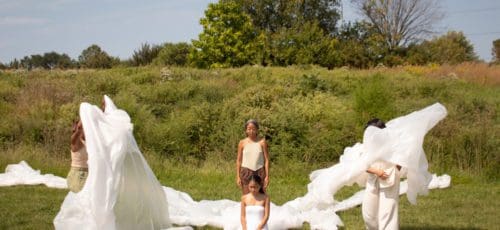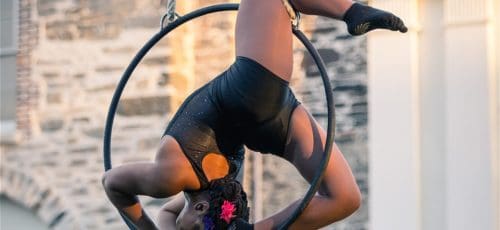Macaroni Necklaces and Jazz Squares: Dancer and Choreographer Rebekah Rickards
Rebekah Rickards greeted a stranger – “Hello!” – and continued walking to the rear of the cafe. She perched on one of the ballooned couches. I watched her from the entrance where I sat; with cropped olive hair and thick-rimmed glasses, she looked the centaur child of Buddy Holly and Bambi. ‘What a hip, benign deer-woman!’ I thought. She walked back toward the door, and smiled at me. “Hi, are you . . .”
I was. And she was.
“I think I always had a really warm, receptive attitude of going out into the world,” Rebekah said later in our conversation, sipping from bottled water. She took a cue from the blistering heat (curse those urban summers!) and wore a long black-and-white marbled halter dress.
“I’m originally from Virginia Beach; born and raised on the beach,” Rebekah said. She studied dance at Old Dominion University in Norfolk, Virginia where she met professor and choreographer Mina Estrada. Addled by post-grad decisions, she opted to join Mina in Philadelphia; “She is my mentor and best friend,” Rebekah wrote in an e-mail exchange. Moreover, the option of moving to New York to pursue dance overwhelmed her: “Being from a small town, Philly felt less scary.”
In our conversation Rebekah circled back to her childhood often, reexamining – and in the process, finding minute contradictions in – what life in her hometown meant to her. “Virginia Beach is not a small town, but I lived a small-town life, just because I was very sheltered, and home-schooled,” Rebekah explained. “My first time stepping foot into a high school I was teaching.” In the fall, she will return to directing the dance program at Arthur P. Schalick High School in Pittsgrove, New Jersey. “I thought, ‘Oh shit, lockers are for real. I’m glad I watched all that Saved By the Bell.’”
Rebekah’s teacher was her mother, and her classmates her four siblings. She is the middle child, “the ‘Stephanie Tanner’ of [her] family lineup,” she added. She remembers her home as a haven for free-range learning, unencumbered by the conventions of institutional education – the restraint of desk and of dress code. “I was the kid doing long-division in a tree, in a Cat Woman costume,” she said. “[My mother] would take us to the beach to learn physics.”
“In a way [being home-schooled] was a double-edged sword,” Rebekah said. “When I moved to Philly I was still pretty naive.”
When she first came to the city she found a room on Craigslist. “For my first summer I lived in West Philadelphia with a Moroccan man named Rachid. He didn’t like to wear clothes . . . or work,” she said. They ended up getting along well.
Rebekah’s 2012 Philly Fringe performance, modern dance explained, is her first independent production in Philadelphia, and though she concedes that her piece doesn’t indeed explain modern dance, she’s interested in exploring the conceptions – and misconceptions – people carry about it. For research, she’s been hitting the (burning) streets: “I’ve been randomly walking up to people and just filming them, asking, ‘When you hear modern dance, what do you think?’ Most people are like, ‘Rolling on the ground, barefoot, abstract,’” she said. “While modern dance does come from that, I think the general consensus is it’s not very accessible to the average person.”
Rebekah strives to make what she defines as accessible: comedic pieces with clear storylines. For her Philly Fringe work, she derived the main character’s mission from her own observations of artists’ tendencies.
“I went to an audition where the woman felt the need to quote how wonderful her work was,” Rebekah said. “She said, ‘Thanks for coming here. My work, as mentioned by the Philadelphia Inquirer . . .’ and she read all the quotes about her. I think sometimes choreographers and artists feel the need to really justify them being there and having something important to say. They want to be taken seriously.”
Her main character desires to be what she perhaps can’t be: the esteemed choreographer, puffed up by the accolades of a citywide newspaper. “[My character] is trying to create this masterpiece to be taken seriously, whereas she doesn’t know what the hell she’s doing and the people [she’s working with] don’t know – so it’s kind of their struggle together to create something beautiful and to be taken seriously. In a conventional sense, they’re not successful. In an unconventional sense, they are.” The unconventional? Jazz squares.
“Dance doesn’t have to be all of the high legs and stuff. Sometimes it’s a jazz square. Maybe the jazz square has something important to say.”
In the summer of 2009 Rebekah trained in improv at The Second City in Chicago, incubator for funny-persons Tina Fey and Steve Carell. “Dance has brought me thus far, into Philadelphia,” she said, but admits that a move to Chicago is on the horizon.
With small black studs in her ears and a silver chain on her right wrist, Rebekah adorns herself simply; enthusiasm, big-bright ebullience, is the shimmer she doesn’t don. As a child Rebekah said she was encouraged to approach the world with gifts in her arms: “’Why wouldn’t they like me? I have all this to offer.’” She credits her mother, a Sunday school teacher in Virginia, with nurturing this attitude.
“I’ll walk into her classroom at her church – they’ll be learning about creation – and there will be tulle, meant to be water, on the ground. It’s all decked out and decorated,” Rebekah said. “She spends hours making these handcrafted crosses with beads that move up. It’s so authentic. It’s so rendered in love, and it’s very visual.”
A slight conversational tick, Rebekah’s shoulders shrug in time with her head, punctuating her thoughts, offering, “Here are my ideas. Why don’t we make things with them?” I place her quickly: the pal to whom there’s nothing greater than lounging in the sun, crafting bargain jewelry, and devising pseudo-dangerous tree-fort missions. At long last, I’ve found my summer-camp sidekick: “Macaroni necklaces,” Rebekah blurted. “I just feel like that’s my artistic voice.”
modern dance explained runs September 9 at 3:00 pm at The Meeting House Theatre at the Community Education Center, 3500 Lancaster Avenue. $5.
–Audrey McGlinchy



